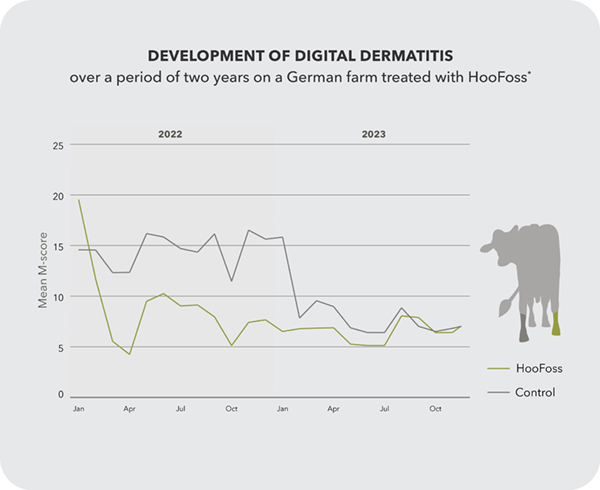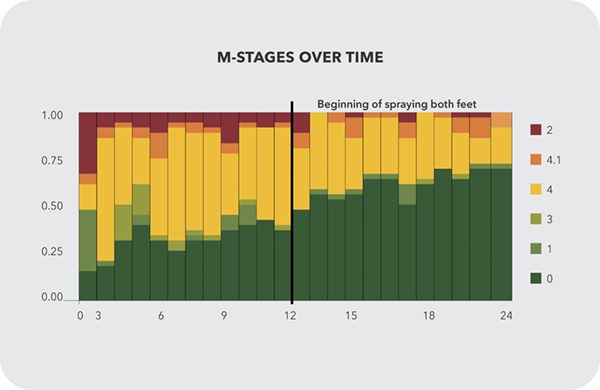HooFoss
- Reduced lameness and better hoof health status in cows
- Lower replacement rate
- Potential increased milk yield
Lameness has a substantial impact on the longevity and performance of dairy cows, including reduced milk yields. It also negatively affects reproductive performance and increases the risk of early culling.
HooFoss mitigates the harmful effects of the hoof environment by creating a protective film on the skin. Once established, this layer adheres firmly to both healthy and damaged skin for several days, providing a barrier that supports the skin’s natural defenses and promotes optimal healing.
By preventing hoof-related disorders, HooFoss helps reduce the incidence of secondary health issues that often stem from lameness, such as reduced fertility, lower milk yields, and increased vulnerability to infections. Maintaining hoof health minimises these risks, thereby supporting overall cow health, enhancing productivity, and extending their productive lifecycle.

Higher M-scores correspond to an increased prevalence and/or severity of Digital Dermatitis cases. The grey curve in the graph above illustrates data from the rear left hooves, which received no treatment in the first year and were treated with HooFoss in the second year.
The green curve represents the rear right hooves, which received HooFoss treatment in both years. The light grey backgroundmarks the division between the first and second year.
The study demonstrated a significant reduction in M-scores with regular use of HooFoss. Additionally, the farm observed a daily milk yield increase of 3 kg and an 11% reduction in the replacement rate over the trial period.

Combining HooFoss and Stalosan F
Studies show that lameness is associated with higher SCC and increased mastitis (Singh et al., 2018). Peeler et al. (1994) found that lame cows have 1.4 times higher clinical mastitis and SCC compared to non-lame cows. HooFoss can support Stalosan F in reducing SCC and mastitis, while Stalosan F helps maintain a low pH in cubicles, enhancing HooFoss’s effectiveness.
Elevated SCC indicates mastitis and other udder infections, impacting cow health and milk production. A German dairy farm reduced SCC from over 350,000 SCC to under180,000 SCC by using both HooFoss and Stalosan F.
Dosage and use:
Apply a concentrated dose of HooFoss 2-3 times per week directly to affected areas using a knapsack sprayer or similar equipment. For optimal flushing and treatment, hold the spray nozzle close to the problem area (1-2 cm) during application. Avoid washing the hoof area before or after treatment.
It is recommended to apply HooFoss spray in the milking parlour, carousel, or in the cow barn. It is also suitable for use on heifers.
After several weeks of treatment, the affected areas may develop a black surface, which should not be removed. This indicates that the treatment is working effectively and should be continued as directed.

